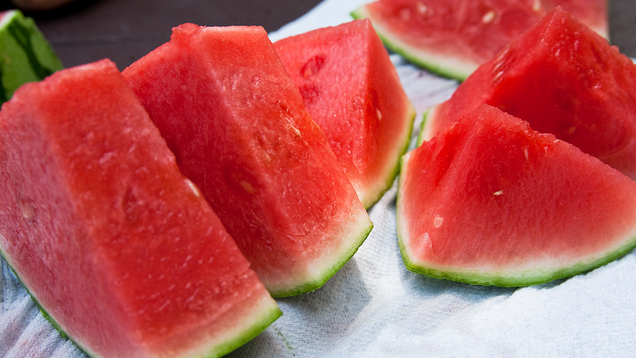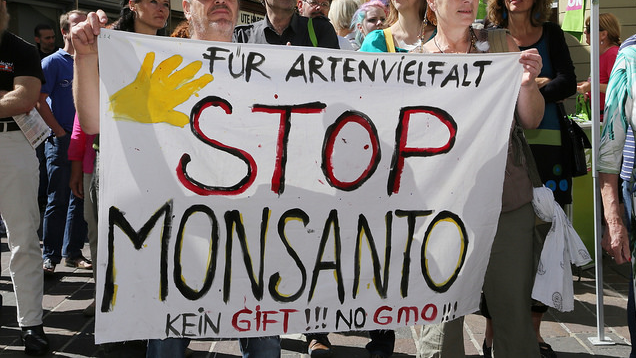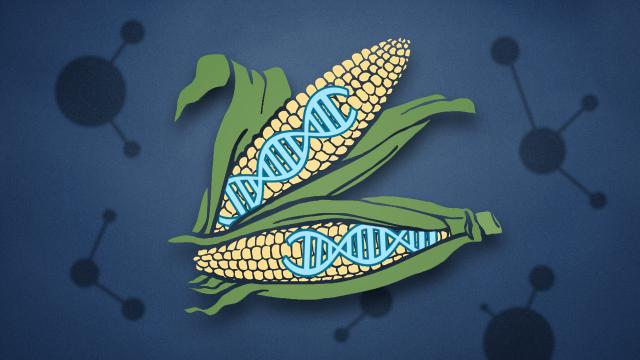Everyone from Greenpeace to the Food Babe rails against genetically modified ingredients, and there are frequent campaigns to ban genetically modified organisms (GMOs) or require changes to labelling laws. But the laser focus on GMOs is misguided, because most of the concerns people raise about them aren’t really about GMOs.
Photos by MDGLillehammer, CIAT, Steven Depolo, Die Grünen Kärnten
There are serious problems with our food system and the way it’s based on industrial agriculture. People on low incomes have trouble affording healthy, sustainably grown produce. Meanwhile, massive amounts of pesticides and fertilisers are finding their way into the environment, and corporate giants like Monsanto have far too much power.
But passing around infographics about which GMO-containing foods to boycott isn’t going to do anything to solve these problems. They will just make it easier for already-privileged people to buy food they feel good about — which may well be just as bad for their health and the environment as the food they’re avoiding. Here’s why.
GMOs Don’t Always Mean More Pesticides

The concern: There are too many pesticides on our food and in the environment.
The truth: Pesticides include herbicides (weed killers), insecticides (bug poisons), and any other chemicals that farmers use to kill things that might hurt their plants. Some pesticides are okayed for use on certified Organic crops, and some aren’t.
What does this have to do with GMOs? Two different things, actually, which GMO opponents sometimes get confused. One type of GMO plant increases pesticide use, and another popular type decreases use.
Herbicide tolerant plants can withstand sprayings of certain weed killers. Genetically modified “Roundup Ready” corn and soy plants were developed by industrial giant Monsanto, which (don’t be surprised) is the maker of the herbicide RoundUp, chemically known as glyphosate. Farmers can buy the seeds and the herbicide, then spray their whole field knowing that the weeds will die and the specially engineered corn or soy plants won’t. Glyphosate was popular even before GMOs, but now farmers have extra incentive to use it.
The bad news: thanks to these plants, farmers now spray massive amounts of herbicide. The good news: at least it’s one of the less toxic herbicides. This leads to a few things: weeds are becoming resistant to glyphosate, so farmers have to use more of it. In an attempt to solve the problem, companies are developing new GMO plants that are tolerant to other herbicides, so the cycle of over-spraying and creating resistant weeds will likely continue.
So is this bad news? Mostly yes, but from an environmental rather than a health point of view. More glyphosate is being used, but it’s not showing up on our food in unsafe amounts. The famous study that claimed glyphosate-treated corn causes cancer turned out to be scandalously bad science, and the paper was retracted by the journal that published it.
However, there’s another kind of GMO plant: crops that produce their own insecticide. They’re called Bt crops because they produce the same natural toxin as the bacterium called Bacillus thuringiensis. Like glyphosate, this was a popular pesticide long before GMOs came on the scene. You can buy both at your local garden centre: the Bt comes in the form of bacterial spores that you spray onto plants, and is great for when caterpillars are eating leaves on plants like cabbage. The bacteria produce a toxin that kills insects who eat it, but even in large quantities the toxin is considered harmless to humans. Mother Earth News calls it “one of the safest natural pesticides you can use”. It was lauded by the same sorts of people that grow their own organic cabbage — until scientists used genetic engineering to put the recipe for the toxin into plants. Now you’ll find people claiming Bt toxin is dangerous to humans (it isn’t) and confusing it with glyphosate.
Not only is Bt toxin safe for humans, its use means that farmers are spraying less insecticide overall — a win for the environment and for farm workers’ health, and a draw for consumer safety (since there weren’t high levels of pesticides on food to begin with).
So do GMOs increase pesticide use? Yes and no, depending on which GMO you’re talking about. You can’t lump them together and say they’re good or bad as a group.
What you can do: To be honest, if you live in Australia and you’re worried about pesticides on your own personal food, the easiest tactic is to just stop worrying. Pesticides aren’t on any conventionally-grown food in dangerous quantities. Meanwhile, buying organic means you’ll still have pesticides on your food — just different ones. And, we don’t have data on whether those are used in dangerous levels or not. If you want farmers to reduce pesticide use in general, start supporting smaller, ideally local farms that are up-front about what kinds of pesticides they use, when, and why.
GMOs Are Unnatural, But So Are Plenty Of Non-GMO Plants

The concern: We shouldn’t be messing with plants’ DNA. It’s unnatural and could have unintended consequences.
The facts: We have been messing with plants’ DNA for as long as humans have been growing plants. Archaeologists know that Native Americans bred the scrawny weed teosinte into the plump-kernelled corn plants we eat today. And 8000 years before we figured out how to insert bacterial genes into plant DNA, the bacteria were inserting those genes themselves; today’s sweet potatoes bear their handiwork.
So the question isn’t whether we should mess with plant DNA, but how.
Think of your DNA as an encyclopaedia of cookbooks, and the recipes tell your cells how to make a person. Plants have a different set of recipes, which is why they end up as plants and not people. If you want a bigger or tastier plant, you’ll need to find a way of changing some of those recipes.
Genetic engineering, as we mean it when we talk about GMOs, means that scientists are taking a recipe — a gene — from one cookbook, and pasting it into another.
In the case of Bt corn and soy, which we talked about above, they took the toxin gene from the bacterium Bacillus thuringiensis and inserted it into a soy or corn plant. In the case of the new Arctic Apple, the gene was cut from one type of apple and pasted into another. (Once the cut-and-paste has been done, you can breed or graft the plants in any conventional way. They don’t have to bioengineer each individual seed.)
Genetic engineering is very precise in terms of the gene you’re inserting, but there’s no way to control where in the plant’s DNA it will end up. If it gets inserted in the middle of another gene, it could mess up the plant’s ability to make that recipe. That’s why plenty of testing and screening is needed before the plant leaves the laboratory, to make sure it still functions as a plant and there were no ill effects. Sound dicey? Compare it to other ways we mess with plant DNA.
-
Mutation breeding involves irradiating plants or their seeds, essentially vandalising random recipes in an attempt to create a mutant super-plant. It’s a technique straight out of 1950s comic books, and it actually works. (Most of the plants die, of course, but a lucky few get super powers like larger or tastier fruit.) It’s how we got the Rio Red and Star Ruby grapefruits.
If you’re worried about mutant franken-plants with unknown changes to their DNA, these are the plants that should concern you. This technique is becoming more common as GMOs are falling out of favour in some countries. The extensive testing and regulation that apply to GMOs don’t apply to these plants.
-
Hybrids are more common, but still weird. When you cross two different plants together, the offspring sometimes show interesting traits that they may not consistently pass down to their own descendants. Some are even sterile, like seedless watermelons and other freaks of nature that people occasionally assume are GMOs. They’re not.
Once again, you can find abundant examples at your local garden store: any packet of seeds produced by hybridisation will say so on the label. If you want to grow a hybrid plant year after year, you need to keep buying hybrid seeds. The seed company makes them by hybridising the two parents each season, like a dog breeder who keeps labs and poodles to satisfy the demand for labradoodles. This is why farmers were often buying new seed every year, even before GMOs.
- Backcross breeding is also used as an alternative to GMOs. This is where you find a gene that you’d like to introduce into your crop, but it’s in another variety or sometimes another, closely related species. For example, in a project at Cornell, plant breeders crossed a butternut squash with a wild squash that was resistant to powdery mildew. The resulting hybrid was disease resistant but tasted terrible, so for years afterward they bred the descendants of that hybrid with butternut squash, keeping the ones that taste like a butternut but still have the disease resistance of the wild variety, and doing it all again next year. It’s a time-consuming process, and is far more likely than GMOs to result in unintended genes ending up in the finished product, since you start with an infusion of thousands of genes instead of just inserting one.
In short, if you’re worried about unnatural DNA manipulation or the possibility of introducing unintended mutations, GMOs are just one of many methods that could maybe, possibly, introduce a mystery mutation. (To be clear, we don’t know of any serious problems that have come up from any of these methods; it’s more hypothetical.) This handy chart from Grist lays out the concerns that apply to different plant breeding techniques, GMO and otherwise. (Grist has done some excellent, unbiased reporting on GMOs. For starters, here is the article that went along with that chart.)
What you can do: It’s just about impossible to avoid plants that have been genetically altered somehow. If you’re very dedicated, you could decide which methods you approve of, find the names of those plant varieties, and look for those when you shop for groceries or for garden plants.
For most people, though, this should be a non-issue: just a glimpse of the bizarre reality behind how your food is (and was historically) made. If mutation breeding or backcrossing honestly bother you, you might consider starting efforts to get those labelled. But since GMOs aren’t particularly more unnatural than these other methods, and since none of them are really objectionable at all (in my own opinion) I’ll be over here eating my Rio Red grapefruit.
Corporations Control Everything — GMO And Otherwise

The concern: Monsanto, maker of GMO crops, is totally evil.
The facts: Agreed: Monsanto and companies like it are bad for agriculture. To be clear, this isn’t just Monsanto: we have to remember that Dow and Bayer, among others, use the same one-two punch to sell GMO seeds alongside their brand of pesticide. The big companies use market leverage and patent law to bully farmers into doing things their way. But here’s the thing: big companies are controlling agriculture for reasons unrelated to GMOs, so a fight against GMOs won’t really reduce the control they have over agriculture.
I really don’t like that these companies own so much of American and global agriculture. But genetically modified crops only date back to the 1990s, and we’ve had industrial agriculture long before that. Banning or embracing GMOs is just rearranging deck chairs.
The health, environmental and economic problems of industrial agriculture have deep roots and can’t be solved with a labelling law or two. Large-scale farms that grow corn or soy in monoculture, with an emphasis on killing native plants (aka “weeds”), are decreasing biodiversity (like the milkweed that monarch butterflies require to reproduce). Nutrient cycles in the environment have been disrupted: Instead of animal manure providing fertiliser for plants on the same farm, we have feedlots where “lagoons” of animal waste create health and environmental hazards, while hundreds of miles away, farmers cover their fields in synthetic fertiliser that runs off into nearby waterways, disrupting ecosystems and killing fish.
Who wins in this scenario? Pesticide manufacturers, for sure (with or without GMOs). Seed breeders (likewise). Fertiliser manufacturers.
Nathanael Johnson, in wrapping up six months of reporting on genetically modified food, lays out the real future that would await us if we could somehow ban GMOs:
In the GMO-free future, farming still looks pretty much the same. Without insect-resistant crops, farmers spray more broad-spectrum insecticides, which do some collateral damage to surrounding food webs. Without herbicide-resistant crops, farmers spray less glyphosate, which slows the spread of glyphosate-resistant weeds and perhaps leads to healthier soil biota. Farmers also till their fields more often, which kills soil biota, and releases a lot more greenhouse gases. The banning of GMOs hasn’t led to a transformation of agriculture because GM seed was never a linchpin supporting the conventional food system: Farmers could always do fine without it. Eaters no longer worry about the small potential threat of GMO health hazards, but they are subject to new risks: GMOs were neither the first, nor have they been the last, agricultural innovation, and each of these technologies comes with its own potential hazards. Plant scientists will have increased their use of mutagenesis and epigenetic manipulation, perhaps. We no longer have biotech patents, but we still have traditional seed-breeding patents. Life goes on.
In other words, GMOs were a red herring all along.
In fact, there are plenty of examples where GMO plants are being used for reasons other than profit, like vitamin-A-containing rice and protein-rich potatoes meant to alleviate malnutrition in vulnerable parts of the world. If we’re fighting over-industrialisation of agriculture, GMOs are the wrong battleground.

Comments
6 responses to “The Biggest Concerns About Genetically Modified Food Aren’t Really About GMOs”
My problem with GMOs are more business based, especially around the idea of “terminator” seeds:
http://science.slashdot.org/story/13/02/19/2212256/monsantos-terminator-seeds-set-to-make-a-comeback
I don’t know how widespread they are now, or if they’re even legal or being sold, but they’re crops designed to yield sterile seeds. For example, you can’t plant crops, take the resulting seeds and plant them again — when you plant them, nothing will grow, forcing you to buy new seeds every season / generation
I’m all for crops that are more resistant to disease or are larger in size or whatnot, but when you start muscling in on small business, forcing them to buy seeds over and over, that’s just shitty.
Hybrids are frequently sterile. Farmers know what they are buying.
capitalising on agriculture and trying to patent seeds that die after one usage is never a good idea.
fuck gmos
Agreed.
This is not all GMOs though. It’s the evil companies co-opting a small facet of technology for their monolithic corporate greed-mongering. GMOs could be used to improve the lives of poor or malnourished people too, but where’s the money in that.
The real problem with GMOs is intellectual property. This really gives corporations unprecedented control over seed that farmers can grow. As far as I’m other mutations don’t carry this issue and if they do, not in the same way at least. For instance, when GMO crops crossbreed with a non-GMO crop, GMO genes can end up in the resulting hybrid. I’ve already heard cases where Monsanto has managed to claim royalties from this. If GMO genes can accidentally spread into crops to the extent where everything is GMO this could have implications for food security.
It is a problem, but certainly not the biggest or only one.
This article is perpetuating myths of GMO while pretending to be a fact based article.
“Concern: Monsanto, maker of GMO crops, is totally evil.
The facts: Agreed”
Really? Evidence please. This is all scare-mongering with limited facts. Monsanto is a corporation like any other and is not ‘evil’. GMO crops are extremely beneficial: lower use of harmful pesticides and higher crop yields are two of the main benefits.
Terminator seeds aren’t in use, although yes Monsanto does own the patent for them. They also don’t sue farmers that end up with cross-pollinated fields.
Scare-mongering at it’s best, but that’s to be expected with GMO’s right? Never let facts get in the way of an agenda.
@ma61turbo — Monsanto has a horrible history with PCBs, of completely lying to the public and selling a product that caused the deaths of many rivers and people. Ecocide and homicide. It’s not just like any other corporation in this sense.
And glyphosate is probably disrupting the human gut microbiome. The science has either not been done or has been hidden. And the industry uses the German BfR as a rubber stamp to say it’s safe. These are all real things.
Genetically engineered foods are on the market only because the U.S. Food and Drug Administration (FDA) has covered up the warnings of its own scientists, misrepresented the facts, and violated explicit mandates of U.S. law. The following points provide the details and describe the solution.The Food Additive Amendment of the U.S. Food, Drug and Cosmetic Act institutes a precautionary approach and requires that new additives to food must be demonstrated safe before they are marketed. (21 U.S.C. Sec. 321) Although the FDA admits that the various genetic materials implanted in bioengineered organisms are within the amendment’s purview, it claims they are exempt from testing because they are generally recognized as safe. Genetically engineered fail all requirements for safety via our FDA guidelines. GMO’s for the most part increase pesticide use by 2/3. Roundup Ready or HT herbicide tolerant crops make up the vast majority of GMO that we are eating every day. From the USDA web site: Roundup Ready crops are absolutely dominating agricultural production of staple crops in the United States. There has NEVER been one single long-term toxicological feeding study of these genetically modified organisms. In spite of the warnings of FDA scientist the FDA allowed them on to the market with NO TOXICOLOGICAL STUDIES. Think about that for a moment. This is heinous. The genetically modified Roundup Ready crops, which even FDA scientists warned contained potential threats to human health, along with their associated herbicide, namely glyphosate or Roundup which is in fact lethal to cells that make up over 90% of the DNA in your body, these plants and their accompanying herbicides were allowed into the global food supply without even one STUDY! Inconceivable but true. Roundup/ Glyphosphate has been linked to ADHD, Cancers to include brain and breast, Diabetes, obesity and Hypertension to name a few.
Never confuse selective breeding with Genetic engineering. The difference is pretty large. In regular cross pollination, the species being crossed have to be related . . . basically respecting their common evolutionary origin. But with GMOs, you can take any gene from any species and splice it into a crop. So you get fish genes in tomatoes or the like.
There is no consensus on the safety of GM food. A peer-reviewed study of the research, from peer-reviewed journals, found that about half of the animal-feeding studies conducted in recent years found cause for concern. The other half didn’t, and as the researchers noted, “most of these studies have been conducted by biotechnology companies responsible of commercializing these GM plants. Which is called tobacco science.
Here is a link to a interesting new Documentary SYNTHETIC FORESTS The Dangers of Genetically Engineered Trees, take a look and see what some corporations would like to do.
http://www.indiegogo.com/projects/synthetic-forests-and-the-dangers-of-ge-trees/x/10584390
Oh bloody hell, not this again
Selective breeding is not the same as selecting genes in a lab!
The goal is the same, the method is NOT
You could never in a billion years get a fish to breed with corn, that is unnatural in every sense of the word
It’s as risky as trying to splice in binary from different computer programs instead of using a compiler
There will be side effects
What I want is long term safety testing which is not being done
Monsanto has a terrible track record for safety and have been known to suppress anything that shows their products as being unsafe
Bovine growth hormone is banned in AU for a reason, and meanwhile Monsanto continues to dominate the biotech industry and use the US government’s muscle to push their shitty business tactics and GM seeds onto the entire planet with unknown consequences
If you want to be a guinea pig, go right ahead and eat GMOs
But label the damn things so people have a choice, cause I’d rather not become sterile or end up with chronic diseases in 20 years time
I highly recommend the documentary: genetic roulette
Actually, glyphosate is not necessarily safe for human consumption at the levels we find it in our food. The effects, which i believe are likely, are not that people get directly ill in the sense of acute toxicity, but rather that the continuous presence of glyphosate in the human gut microbiome changes the microbial populations there to favor pathogenic bacteria and disfavor beneficial bacteria.
This has not been studied by anyone. There has not been a research study to test this. This is an unknown, and i believe the hypothesis to be likely, based on my literature review of hundreds of studies on the basic biochemistry of glyphosate, as well as its effects on microbial populations in the soil and in plants (endophytic bacteria).
Glyphosate is in our foods at levels probably averaging about 1 mg/kg, and we probably ingest around 100 micrograms per day in a typical western diet.
This puts it in the relevant dose range. We need to do the science. It is not right to claim that glyphosate is safe until this research is done.
Disrupting the populations of the human gut microbiome would not lead to immediate acute disease, but could have profound effects over time and increase other disease likelihoods and outcomes. This is not a nit-picking thing to want to check out. It’s a serious thing.
Every single day, most of use are ingesting a dose of a potent microbicide that has differential effects on the various microbes in our own gut, those who help us and those who can hurt us.
Let’s see the research.
There is indeed a lot of glyphosate in our foods.
Here’s an idea for how to “burndown” the field before planting with no herbicides. Currently, glyphosate is used for “burndown” to clear fields before planting, especially a lot of non-GMO crops, as it cannot be sprayed while the crop is growing in that case.
Y’all can thank me later.
You know about flame burndown? You use a propane flamethrower on the field right before seed emergence, ideally. It kills the weeds that have emerged, by burning the leaves and rupturing cells. No chemicals at all, just propane.
Well you could do that with biogas and close the loop, not use fossil fuels.
But even better, we can invent a solar-powered field burndown machine. We could make a solar cooker that magnifies the sun about 8X and stays long enough on each part of the field to kill the weeds there. It can go on autopilot, with solar-powered motors to move around. Totally doable.